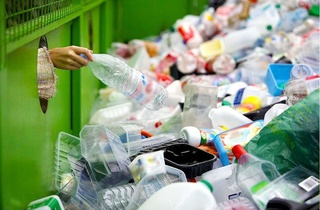Within the scope of the research, a total of 104.8 million tons of waste, of which 30.9 million tons was hazardous, was generated in manufacturing industry establishments, mining establishments, thermal power plants, organized industrial zones (OIZ), health institutions and households, in 2020. The total amount of waste increased by 10.5% compared to 2018.
Manufacturing industry establishments generated 23.9 million tons of total waste, of which 4.6 million tons was hazardous. Out of total waste, 56.3% was sold or sent to licensed waste treatment facilities, 24.2% was sent to landfill sites, 7.1% was stored within the establishment site, 7% was recovered within the facility, 3.2% was collected by municipalities or organized industrial zone's managements, 1.7% was sent to co-incineration or incineration plants, 0.4% was used as filling material or for reclamation and 0.1% was disposed of by other methods.
Mining establishments generated 27.6 million tons of waste, excluding overburden. 99.995% of the total waste of 896.4 million tons including overburden was mineral waste. Out of the total amount of waste, 71.3% was disposed of in heaps for overburden, tailing dam or controlled landfill sites, 26.4% was used for backfilling and 2.3% was recovered or disposed of by other methods.
24.4 million tons of waste, of which 10 thousand tons was hazardous, was generated in thermal power plants. Out of the non-hazardous waste, 79.5% was ash and slag waste and 20.5% was metal, paper, plastic waste, wastewater treatment sludges and household and similar waste. Regarding the treatment of waste, 85.9% was disposed of in ash disposal area/ash dam or controlled landfill sites, 13.2% was sent to licensed waste treatment facilities and used for backfilling of mines and quarries whereas 0.9% was disposed of by other methods.
Originating from the activities of organized industrial zones' (OIZ) directorates such as infrastructure services, wastewater treatment etc., 279 thousand tons of waste, of which 117 thousand tons was hazardous, was generated. Out of the total waste, 6 thousand tons was recovered or temporarily stored within the OIZ, 208 thousand tons was recovered outside of the OIZ, and 66 thousand tons was disposed of within or outside of the OIZ. Out of the amount disposed of, 59.4% was disposed of in controlled landfill sites and 40.6% was sent to municipal/OIZ dumping sites.
110 thousand tons of medical waste was collected from health institutions. 23.7% of the total medical waste was collected in İstanbul, 7.8% in Ankara and 5.8% in İzmir, thus 37.3% of the total medical waste was collected from the health institutions located in these three metropolitan cities. 90.6% of the medical waste collected was disposed of in landfill sites after sterilization, and 9.4% was sent to incineration plants.
32.3 million tons of municipal waste was collected
1 387 municipalities out of 1 389 provided waste services. It is determined that municipalities, which provided waste services, collected 32.3 million tons of waste. Out of the total waste, 69.4% was sent to controlled landfill sites, 17% to municipal dumping sites, 13.2% to waste recovery facilities and 0.4% was disposed of by other methods such as burning in an open area, burying and dumping into river/onto land. The average amount of municipal waste per capita per day is calculated as 1.13 kg.
After wastewater treatment processes operated by municipalities, 314 thousand tons of wastewater treatment sludge (in dry matter) was generated.
127.4 million tons of waste was treated in waste treatment facilities
Out of the 127.4 million tons of waste treated in waste disposal and recovery facilities, 78.3 million tons were disposed of and 49.1 million tons was recovered. Total amount of waste treated increased by 22% compared to 2018.
The total capacity of the controlled landfill sites was determined as 1.2 billion m3. 77.8 million tons of waste, of which 31.9 million tons was hazardous, was disposed of in a total of 174 controlled landfill sites.
In co-incineration plants having waste recovery licences, 1.3 million tons of waste was incinerated with energy recovery. A total of 47.6 million tons of metal, plastic, paper, mineral, etc. were recovered in other licensed waste recovery facilities, excluding compost and co-incineration plants. (ILKHA)



 Güncel
Güncel
 Güncel
Güncel
 Güncel
Güncel
 Dünya
Dünya
 Güncel
Güncel
 Dünya
Dünya
 Bilim & Teknoloji
Bilim & Teknoloji
 Güncel
Güncel
 Güncel
Güncel
 Güncel
Güncel





